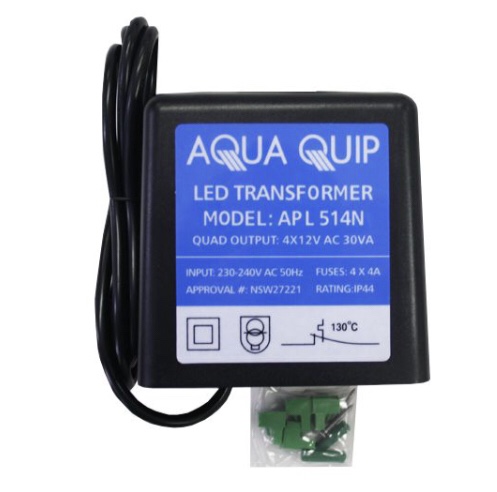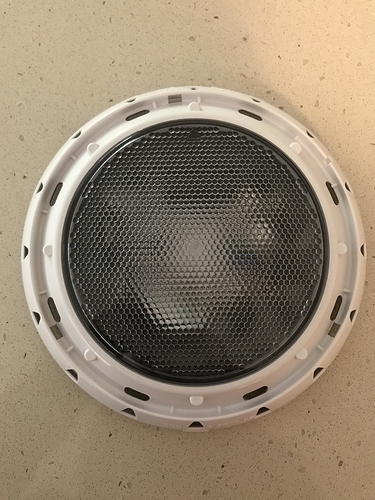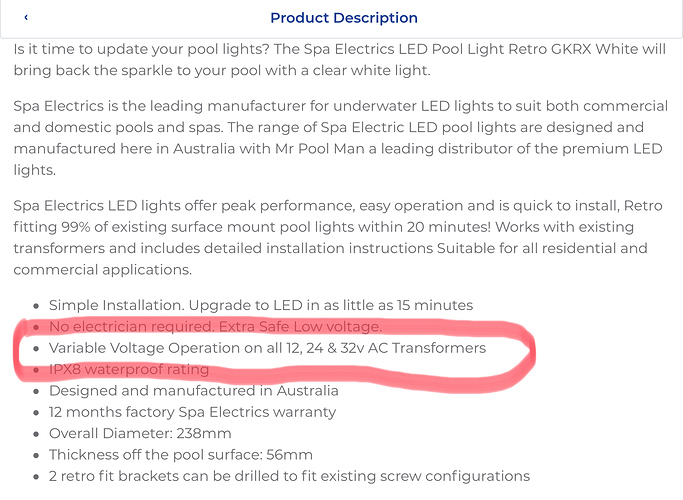I had a new pool light installed in 2019. It comes in two pieces a bracket attached to pool and a light the sits in bracket.
The light recently failed, even though they are suppose to last for about 30,000 hours, it’s been used prob less than 50 hours and has 12 month warranty which has passed.
I asked company for price to replace light as I didn’t need another bracket, I was told that’s not possible you need to buy the whole kit.
It honestly doesn’t seem correct, I compared it to my lights in house, I don’t have to buy a new socket every time I have to replace a blown globe.
Welcome to the community @lazydaisy
What you are probably experiencing is the spare parts system that company uses, and your light could be referred to as the ‘field replaceable unit’ that is sometimes what can be replaced, and sometimes what they stock to sell.
There are numerous examples, especially in auto parts, and this practice is not unique.
Your best path forward is to ascertain the ‘make and model’ (voltage, base and lumens) of the light and check your local pool supply shops, ebay, Bunnings, or local electrical supply for a similar light/LED. It is unlikely your light is a one off design.
I appreciate your response, thankyou
It may also be a safety issue eg the seals that keep the water out may be affected by the bulb removal.
It is good to be aware of the potential for leaks and the safety aspects surrounding replacement but there are many videos and how-tos from manufacturers, installers, and youtubers on changing the pool lights, including disassembling the fittings and removal from brackets.
I read a few and none looked ominous and many replacement bulbs are easily obtainable. Of course it depends on @lazydaisy’s actual light unit whether hers is replaceable, but from a survey of the net, the bulb should be replaceable unless it is an unusual unit. Without knowing the make and model of her light not much more we can speculate.
All pool lighting has to be low voltage and supplied power from a certified isolation transformer and power supply to minimise electric shock risks.
It is most likely these days a LED light. In which instance the LED and power supply will be integrated into a single waterproof housing. Typically low voltage AC - 12V these days.
If @lazydaisy can supply some further details perhaps there is scope for a claim outside of the suppliers 12 month warranty under the ACL. One might expect a LED pool light sold with an up to 30,000hr life to have a reasonable lifetime of many years.
The lights can cost from $300 each. The main component will be the sealed LED housing, electronics, LED’s and lense. No need though for a replacement to require a new socket, which is the lower value part. Some do come with designer styles that may match the surround of the socket/mounting bracket to the face of the sealed LED unit.
P.S. edit added
How it’s typically done with a replacement LED unit.
Very different from the old style housings.
https://poolandspawarehouse.com.au/amfile/file/download/file/119/product/2800/
Hi @lazydaisy, welcome to the community.
Do you have the make and model of the light?
While the installer may say that you have to buy a whole new fitting, it is possible that only the lamp needs replacing should it be able to be removed (not an all in one sealed unit). Knowing the make and model, we might be able to do some hunting around for you.
Edit: The company may say that the full light needs replacement, as they don’t carry spare parts. This doesn’t necessarily mean that spare parts, if the light can be disassembled, from other sources (including online). This is where the make and model is important. I have been in the situation where a company who manufactured a basket waste trap said that they don’t carry spare parts, only to find out that another plumbing parts manufacturer had spares. The savings were considerable.
The other question, is the light underwater, if it is, can it be removed safely without emptying the pool to below the light level?
Welcome to the community.
I had to replace an old pool light, and found a distributor who sold LED units which changed colour by remote control. All well until trying to fit the new light to the old bracket. They couldn’t be married up.
Long story short, the pool had to be drained to the below the light’s level so the new bracket could be fixed to the wall. It has worked well for years. Hopefully the next time we have to replace the light, it will be a straight swap.
Now to your situaltion. The pool light I bought was made in China and the bracket was included in the box. There was no option to just buy a new light without bracket. I would suspect the same applies to the business you have been dealing with. The bracket is plastic, and not an expensive item, and it would a waste of space, effort, and cost, keeping the light and bracket as seperate inventory.
Consider how many pool lights there might be in Australia, versus the number of light fittings there are in an average home multiplied by the number of homes in Australia. The pool light numbers pale into insignificance.
A better comparison in terms of numbers could be something like electronic door bells. Can you buy spare parts for them?
Hi it’s the GKRX retro series from Spa Electrics.
The light has been removed and no apparent leaks or cracks.
I contacted company and they said to post it back at my expense.
If there is a comparable made by another company I would be very interested please
You need to post it back if claiming under Australian Consumer Law (ACL) but keep the receipt as the reasonable costs of postage/transport are claimable if the light is found to be faulty/defective. Only for large bulky items are the sellers required to arrange and pay for transport upfront, but they are able to claim the costs back if the item is not defective, ie this means if not covered under ACL major or minor faults. Warranty of 12 months may not matter if the unit is found to be a defective build, ACL overrides many of those limitations. As it is sold on the basis that it has top durability year after year and has a rated lifetime of 50,000 hours they need to uphold their sales pitch.
After reading the manual it is clear that there is no separate bulb.
The manual for installation on page 2 makes it quite clear there are no user serviceable parts and disassembly of the light (this is not the brackets) voids the warranty. The wiring area after wires are connected is sealed with a gasket and the void in the wiring section is filled with a compound (possibly a silicone one) so no water can get in. This is definitely not a user serviceable build after this has been completed.
The inclusion of the 2 brackets is standard with the light so I assume it comes as a single package with no option for just the light component.
$268 or thereabouts to replace the unit if it isn’t faulty/defective.
Hi mark_m
Just a slight correction: LED lights do not operate on AC-!2-volts. The "drivers"for LED lights are (must be) DC. If you connect an LED to a DC transformer, as used for 12-V halogen lamps, the LED will not last long and they could strobe OF and OFF.
As for an ‘in-pool’ light, the ‘driver’ or any other transformer must not be integral. The lighting supply must be at 12-V (extra low voltage) anything else is illegal!
I am not sure of the circumstances of the problem light, but if it is an in-pool light, there is a possibility that it is a full sealed fitting which does not allow the LED lamp to cool. If they get hot, their life is drastically reduced. While it would be assumed the water would provide cooling, the heat from the sealed fitting may not be able to be conducted away?
My advice: Do NOT be miserly about the cost to repair the light whether it is in the pool or even next to the pool! Get it wrong and the consequences are far greater than the cost of a qualified electrician to fix the problem. Pools are very dangerous when near electricity: it is your life or the life of a loved one you are putting at risk.
It has an external heatsink to increase the cooling by the water. The manual is clear that the unit must be fully submerged before operating. Operating out of water or even only partially submerged voids the warranty and most likely any Australian Consumer Law protections.
The manual also is clear that the light will work with any transformer in the range of 12 to 32 volts. It then has internal voltage adjustment to lower the supply to the needed level and type for the LED. It is a sealed all in one unit.
Sorry Alan if I was not concise. I do make the occasional error and am happy to correct. In this instance I can clarify:
Here are the details of a typical modern LED Pool Light power supply. Some lights are supplied with a special controller to enable colour changes and a bit of a light show. For those unable to read the certification or power details, it can power 4 isolated LED pool lights with 12V AC. The rest of the details per the link.

Many replacement (retro fit) LED pool lights are designed to utilise the previously electrician installed approved power supplies. EG 12VAC for halogen or 32VAC tungsten filament.
From one example:
The LED light assemblies as @grahroll noted are integrated with their power supplies. These include the AC to DC, voltage regulation and white/colour LED drivers.
I’m not sure how I gave the impression I was suggesting anything unsafe with my opening comment?
Retrofit LED lights are designed to minimise extra expense by utilising the power from the original electrician installed lighting supply. This includes existing isolated supplies of up to 32V. I’ll leave a detailed discussion of the SAA Wiring Rules, the applicable Australian Standards and different Electrical Safety regulations of each state and territory government to another forum. These include recent revisions to the bonding (earthing) requirements of metal within the pool electrical exclusion zone.
Depending on which state you reside in DIY to replace an old style light with a new LED may be classified as restricted electrical work, in difference to the view of the above supplier. It pays to check first.
This only applies for some if the old transformers. Modern 12V drop down voltage systems are designed for both halogen and LEDs.
Sorry, but it depends what you mean by ‘old’. If you mean the wire wound transformer and rectifier, then they will work with LED lamps as the tend to provide a ripple free DC.
However, the electronic transformers for halogen 12-V lamps are definitely not suitable for LED lamps as they are not DC but have a 12-V AC ripple which will cause the LED lamps to strobe and have a short life. Halogen lamps will work with AC or DC as long as the voltage is right!
LED lamps are just another form of electronics, ie literally a “Diode that emits light”. Like all electronics they require a true DC - just like your smart phone or computer. A battery is the best examples of pure DC.
The electronic ‘drivers’ that are externally connected to an LED will deliver a true DC supply, so will the built-in electronics for a 240-V connected LED. All the AC ripple is filtered out.
Sorry, if this is a bit pedantic, but lighting design was one of my areas of expertise. I retired before LED’s came on the market, much to my disappointment as many project would have been much easier with these high efficiency, long life lamps!
Apologies, I forgot the word electronic. Most earlier generation electronic transformers were only halogen compatible…LEDs installed on such transformers may flicker or fail prematurely. A lot of more recent electronic transformers are LED compatible, but one needs to check when purchasing as some halogen only electronic ones are still available.
It is common place and good practice to use extra low voltage AC (<50V) in environments that are potentially wet or very humid. DC will cause electrolysis where a conductive interface (moisture) is present and very quickly destroy any metals in the mix whereas AC will not. This is why you never see DC used for pool light uses and irrigation solenoids.
The drivers of LED pool lights like this are absolutely integral in the head unit. They have to be in order to supply the LED chips what they require. The feed from the isolation transformer to the light fitting will be AC in the range of 12-32V for the above reasons.
It’s important to distinguish between in pool lighting design and what might be done in a typical house lighting design. Pool electrical design requirements for lighting are determined from the SAA Wiring Rules.
Perhaps this is where there is some confusion. The regulated electrical requirements are definitely not the same, in particular with respect to LED lights.
As @V8Snail has pointed out in pool lighting is low voltage AC powered. It is a requirement from the SAA Wiring Rules.
Standard residential lighting power supplies, transformers, or LED lights are not legal/approved for in pool use.
Any one constructing a new pool and installing lights is required under the most recent revision to SAA AS3000:2018 (Wiring Rules ) is restricted to 12V AC powered lighting.
Pool owners with existing non LED in pool lighting can retrofit LED lamp assemblies. These can operate on a range of AC voltages of the existing lighting supplies, as previously noted. This is possible since they are manufactured as an all in one light complete with integrated electronic drivers.
There is no need with in pool LED lighting for separate or external drivers for low voltage. However this might be the case where household 12V halogen lighting is upgraded to LED.


